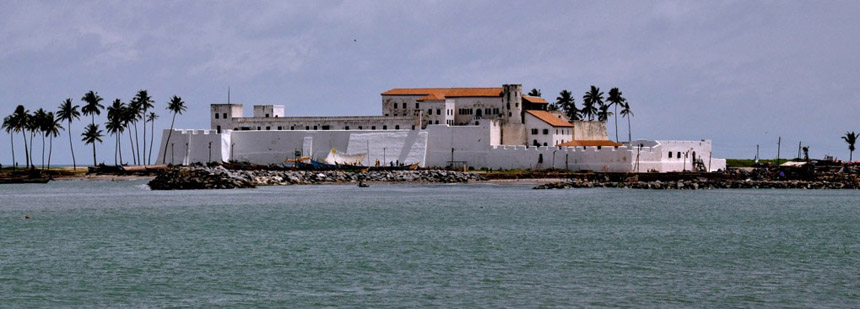Prof. Perucchio helps organize symposium on preserving historic structures

At Elmina, Ghana, Renato Perucchio has stood in the trade castle (shown above) that the Portuguese built in 1482. It was the first European settlement in West Africa.
“When I enter that place and touch the walls, I feel the blood of all the slaves who were there,” says Perucchio, a Professor of Mechanical Engineering at the University of Rochester and Director of its Archaeology, Technology, and Historical Structures Program. “I have goose bumps. It gives me an electrifying sense of being at the place where two civilizations came in contact -- for good and for bad.”
But he can feel something else when he touches those walls – the crumbling of the mortar that has held this fort together for more than five centuries, but is now being seriously eroded by the elements.
The challenge of preserving historical sites and monuments, in other words, extends even beyond such outright depredations as the recent destruction of the Temple of Bel at Palmyra, Syria by ISIS.
Five other scholars from the U.S., Singapore, Ghana and Italy will join Perucchio on campus this Wednesday, March 30, to discuss the "Analysis and Conservation of Cultural Heritage Monuments: Challenges and Approaches Across Disciplines," at a symposium from 3 to 6:30 p.m., in the Wells-Brown Room of Rush-Rhees Library. The symposium is free and open to the public.
The speakers and their topics are:
1. Michael Walsh, Nanyang Technological University: "Conflict and Culture in Cyprus: A Heritage Project in an Unrecognized State."
2. Perucchio: University of Rochester:"Engineering Digital Models of Complex Heritage Monuments."
3. Christopher DeCorse, University of Syracuse: "A Disappearing Past: Development, Archaeology, and Cultural Resource Management in Post-Conflict Sierra Leone."
4. Paolo Vitti, University Roma 3: "Preserving Identity through Cultural Heritage: the Restoration of the Armenian Church in Nicosia, Cyprus."
5. Michael Jarvis, University of Rochester: "Digital Archaeology and Historic Visualizations: Case Studies from Bermuda and Ghana."
6. William Gblerkpor, University of Ghana: "Conserving a Cultural Fortress: Krobo Mountain, Ghana."
In addition, Vitti will give a free lecture, open to the public, on "Mausoleum of the Hadrian Rediscovered: Architecture, Function and Symbolism," 7:30 p.m., March 31 at the Memorial Art Gallery.
'We really need to understand the backbone of these structures'
The scholars will also be meeting separately to discuss the possibility of launching a multi-disciplinary, multi-university project, drawing upon engineers, historians and archaeologists from three continents, to do a detailed study the castle at Elmina as a representative example of the scores of similar structures built along the coasts of West Africa.
The goal would be to produce a “general management plan, a document that will identify the technical and construction aspects of these structures, the problems that are impending, and the type of interventions needed to preserve them,” Perucchio said.
This would extend beyond scanning 3D renderings of Elmina’s surfaces to include thermography and ground penetrating radar to understand the inner structure and foundation. “We really need to understand the backbone of these structures,” Perucchio said.
This will not only shed light on how to preserve structures like Elmina, but the many questions about:
• how they were built, and later modified,
• why the transfer of construction technology from Europe was successful in some cases, less so in others
• how these techniques were eventually assimilated into the cultures where they were introduced
Physical conservation of our monuments is a critical task. “So much of our culture is associated with the physical reality that we created,” Perucchio said. It would be a “gigantic mistake,” he added, to assume it would be enough to preserve these structures as 3D renderings alone.
“Physical reality is something that we will never be able to understand in its complexity unless it is still there, open to new ways of enquiry. Virtual reality like the digital engineering models we use for analysis is an abstraction. It is an approximation and it can be a useful tool in exploring and understanding these structures. But no matter how many pixels we use, it will never replace the reality.”
(The symposium, made possible by the Selwyn Endowment Fund, is co-sponsored by Nanyang Technological University, the University of Rochester and the University of Ghana.)
Below: This photo by Perucchio shows a centuries old fort along the African coast that exhibits fractures in the walls resulting from the erosion of the foundation.

